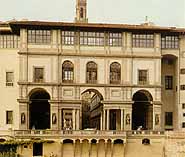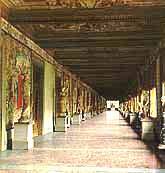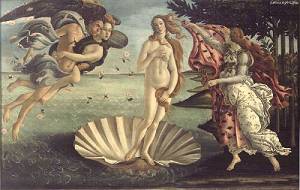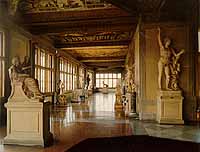Firenze - The Uffizi Palace
The Uffizi Palace
The Uffizi Palace is one of the most loved monuments of Florence. An architectural work of great importance, that shelters masterpieces of inestimable value. Comissioned by Cosimo I, it was designed by Giorgio Vasari around the middle of the 16th century. In order to realize the project, Vasari had some of the buildings surrounding the area demolished.

Among these the church of San Pier Scheraggio, in via della Ninna. The intention of Cosimo I was to build a palace that could host the thirteen administrative and judicial Magistrature or Uffizi, from which the palace will get its name.
When Vasari died, the construction of the Uffizi was handed over to Buontalenti and to Alfonso Parigi. Buontalenti projected the Teatro Mediceo according to the will of Francesco I, the son of Cosimo I, in 1586. when Florence was the capital of Italy the theatre was the seat of the Senate.
The building has the unusual and singular horseshoe shape, also called U shape, which opens towards the Arno River. The two bodies of the building are parallel and conjoined by a connecting corridor that has six big arched windows that open over the courtyard of the palace and over the Arno River. The two floors of the building, divided by string courses, stand over a portico that runs along the whole length of the palace and is sustained by pillars. In the niches of the portico are the statues of the Florentines who distinguished themselves from the Middle Ages until the 19th century. At the present day the Palazzo degli Uffizi hosts one of the most admired and visited museums in the world for the quality of its artworks and the history that accompanies them from the 13th century to the 18th century: the Uffizi Gallery.
In 1993 the Palace was involved in the bombing attack at the Accademia dei Gergofili undergoing damages and loses of inestimable value; another act of vandalism against a patrimony of the world that managed to resist and to win returning, after a long restoration work, to its original splendour.
The Uffizi Gallery
Founded by Francesco de' Medici to delight himself during his walks, the Uffizi Gallery has become through the centuries one of the most famous and admired museums in the world.
It was Francesco I de' Medici who created an art Gallery on the second floor of the Palazzo degli Uffizi to delight himself, during his walks, with the collection of paintings, sculptures and arrases belonging to the Medici family. Thanks to Anna Maria Luisa de' Medici the Gallery became a "public and inalienable good": the Duchess, in fact, handed it over to the Lorena family providing that it would remain open to the public. At the present day the Uffizi Gallery is one of the most famous and celebrated museums in the world, the symbol of the vocation for collecting and to patronage. An interesting group is represented by the artworks commissioned by the corporations of arts and trades thanks to their economical, cultural and artistic exchanges, Florence has become the world capital of art and, especially a meeting and exchanging landmark for the most important Italian and foreign artists. Other artworks come from private donations, from diplomatic exchanges, from antique convents and dynastic inheritance.
The entrance is located under the left portico. After the ticket office you access the Aula di San Pier Scheraggio, the still existing central aisle of the antique church which was destroyed to widen via della Ninna. Presently it is an exposition seat rich of decorations belonging to the Roman and Medieval ages among which historical-religious frescoes by Andrea del Castagno. From the ticket office you enter the Monumental Staircase by Vasari which leads you to the first floor. From the big hall you pass on to the exposition and reference room of the Drawings and Prints Cabinet: a vast collection of drawings by artists such as Leonardo da Vinci, Michelangelo, Pontormo, Vasari and others. The collection, among the greatest and most important in the world, has very antique origins. It was started by the will of Lorenzo de' Medici and it was continued by his followers. It cannot be visited at the present day for studying reasons. After the Drawing and Prints Cabinet there's the Library and the areas reserved for temporary exhibits.
The Gallery is located on the second floor.
First Corridor
In the first corridor the examples of sacred art, of the Renaissance and the artworks by Flemish artists narrate a nostalgic and enlightened past through the alliance between art and spirituality.
The entrance hall to the Uffizi Gallery hosts Roman age sculptures belonging to the Medicean collection: plaster moulds and copies which serve as an anti-room to the museum. The first museum serves as an access to the rooms that expose artworks belonging to the 13th, 14th, 15th and 16th centuries. Along the perimeter of the corridor is the Medicean collection of head moulds and sculptures placed at regular intervals with one statue and two head moulds. On the vaults are frescoes that represent animals, imaginary monsters, satyrs and feats and Medicean achievements. Under the vaults are the portraits of famous men and rulers from all over the world.

The first rooms are dedicated to the art of the 13th and 14th centuries. Here we find examples of sacred art among which the Madonna d'Ognissanti by Giotto, the Maest? di Santa Trinita by Cimabue and the Maest? by Duccio di Buoninsegna. From the 14th century in Florence and Siena the Triptych of San Matteo by Andrea di Cione, the Polyptych of San Pancrazio by Bernardo Daddi and the Presentation to the Temple by Ambrogio Lorenzetti (rooms 3-4). The rooms 5-6 are dedicated to the international Gothic: by Lorenzo Monaco the Adoration of the Magi. Among the artworks of the early Renaissance the Coronation of the Blessed Virgin by Beato Angelico, the Battle of San Romano by Paolo Uccello, Portrait of the Dukes of Urbino by Piero della Francesca (room 7).
In the rooms 8 and 9 are the artworks by artists such as Filippo Lippi: the Coronation of the Blessed Virgin, the Adoration of the Magi; by Antonio del Pollaiolo A Female Portrait, Hercules and Antes. Followed by the masterpieces by Botticelli: La calunnia, Primavera, the Birth of Venus, Adoration of the Magi, Madonna della Melagrana, Coronation of the Blessed Virgin.
The Renaissance is celebrated by the paintings by Leonardo among which l'Adorazione dei Magi and the Annunciation and by Perugino la Piet?, (room 15). In the Tribune is the 16th century in Florence with Medicean portraits by Pontormo. By Rosso Fiorentino l'Angiolino musicante and by Andrea del Sarto la Dama col Petrarchino. In a series of adjoining rooms are the works belonging to German art of the 15th and 16th century and paintings from Lombardia and Emilia that evoke mythological tales and detailed Flemish landscapes (rooms 19 -23). Among them Adam and Eve by Lukas Cranack, Adoration of the Magi by Andrea Mantegna, the Blessed Virgin adoring the Child by Correggio.

Second Corridor
In the second corridor, with wide windows, is disclosed an impressive foreshortened view over the city which narrates itself through art. The second corridor, also called 'midday corridor', is certainly one of the most enthralling places of the whole Palazzo degli Uffizi. It's the connecting corridor between the two wings or structures which give the palace its unusual horse-shape. The impressiveness derives from its long windows that enlighten it and from which you can catch a glimpse at some views of Florence: the Ponte Vecchio, the Vasari Corridor, the Arno River, the hills: live postcards flow under the enthusiast eyes of those observing the harmony of the hilly landscapes and the serene gayness of the streets and of the elegant bridges of Florence.
On the vaults are the precious grotesque frescoes: among them a painting representing a pergola with birds, flowers and plants and the Virtues of the Medicean Grand Dukes by Nasini. Only the Miniature Cabinet opens on this corridor, originally called Camera degli Idoli (the Room of the Idols) and afterwards Camera di Madama (the Madam Room) since at first it hosted a collection of bronze statues and then the jewels of Cristina di Lorena.

On the vault the Allegory of fame by Filippo Lucci. In the oval room is kept the collection of miniature portraits most of which come from the collection of Leopoldo de' Medici. Very characteristic is the marble pavement. The inlaid marble creates an image of a big carpet. Along the entire corridor, under the frescoed vaults, are the portraits of the rulers from all over the world. Among the sculptures is a Roman copy of Love and Psiche and numerous sculptures from the Roman age: flexuous female bodies and the powerful muscles of heroes and divinities.
Third Corridor
The 16th century artworks by artists famous worldwide such as Michelangelo, Raffaello Sanzio and Rosso Fiorentino open the collections of the third corridor. Like the two previous ones, the third corridor has grotesque frescoed vaults which depict animals, famous personalities and Medicean achievements. Here as well there are the portraits of the 'Jovian series' with the royalties from all around the world and the Roman statues.
The museum's pathway starts again with the rooms 25- 27, which host the Florentine painters of the 16th century: by Michelangelo Buonarroti the Tondo Doni or Sacra Famiglia con San Giovannino; by Ridolfo del Ghirlandaio la Coperta di ritratto; by Raffaello Sanzio la Madonna del cardellino; by Andrea del Sarto la Madonna delle Arpie. By Pontormo Cena in Emmaus, by Rosso Fiorentino la Madonna col Bambino e Santi, artworks that introduce a dramatic manierism. Tiziano is represented as the most illustrious exponent of 16th century Venetian art (room 28): by the artist there's la Venere d'Urbino, Flora. Among the examples of Italian painting in Europe in the 16th century (rooms 29-34): by Tintoretto Leda e il cigno (Leda and the swan), by Parmigianino Madonna dal collo lungo (Blessed Mary with a long neck), by Giorgio Vasari La fucina di Vulcano (the furnace of Volcano).
From the 17th century, Rubens with the portrait of Isabella Brandt, Diego Velasquez with Filippo IV of Spain riding a horse. Followed by the room named after the queen Niobe: sculptures based on a mythological theme portraying the woman trying to protect her children from the deadly rage of Apollo and Diana who are shooting fatal arrows against them (room 42). Following there are the 17th century collections through the examples of the Bacchus, The sacrifice of Isaac and Medusa by Caravaggio; by Rembrandt the Juvenile self-portrait and the Venetian foreshortenings and views by Canaletto (room 44). Next to this last room is located the entrance to the bar and to the terrace of the Gallery where you can admire the architectural masterpieces of the city such as the Tower by Arnolfo di Cambio which towers over Palazzo Vecchio and the Cupola by Brunelleschi.
A COLLECTIONS STORY
The age long exhibition problems concerning the 17th and 18th Century art, once a prevailing concern for the Gallery. Only a minimal selection exhibited since World War II.
The preparation of the exhibition project for the recently reopened Caravaggio, Rembrandt and 18th C. rooms, of which I have had the primary responsibility as Director of said department, has reproposed more urgently the problems that have concerned the Uffizi' 17th and 18th Century collections: the area available for their exhibition has been noticeably reduced in a progressive fashion since the post-war era. Although it is sufficient to bare in mind the museums age old exhibition problems in order to understand that these works have always been represented, sometimes even in a predominant fashion with respect to the Renaissance and "Primitive" era.
In the very same Tribune, area originally destined to house the very best of the collection and which now houses the important 16th Century works, they have been alternately exchanged over time works believed (and today still partially recognised signatures) to be of, among others, Albani, Caravaggio, Carracci, Domenichino, Dou, Guercino, Lanfranco, Pourbus, Reni, Rubens, Van Dyck. They were truly works of the 17th Century (Rubens, Sustermans) which graced the new rooms of Niobe, a prime example of Lorraine architecture; whilst at the same time in the Gallery's corridors, turned into picture galleries (moreover rather varied) important and qualified 17th and 18th C. works were exhibited.
The reorganisation of the museum following the Napoleonic upheaval and the general storage reconnaissance during the 19th Century witnesses the progressive strengthening with new found historical acclaim, other than the prestigious works of the older eras, of the presence of paintings belonging to the era in question (Snyders, Honthorst, Seghers, Batoni, Fabre) according to the even more extensive documentary criteria, following the transition to the Italian monarchy, the Gallery was destined to house purely antique paintings and sculptures.
Thus it is not surprising that at the beginning of the 20th Century, possibly the peak for listings of works in the museum (note the Pieraccini catalogue, 1910), one finds almost exclusively 17th and 18th Century paintings adorning the 2nd and 3rd corridor walls, and also in the rooms dedicated to watercolours and miniatures, and those of Giovanni da San Giovanni, Baroccio, Rubens. The Vasari Corridor exhibited 328 portraits of the "iconographic" collection, almost all dating to the 17th and 18th C., periods in which, up until 1926 (Poggi catalogue), were reserved practically eight rooms.
Following World War II, the situation was notably different with the new clear ordering of Roberto Salvini in strict chronological order sub-dived by schools which, asides from the massive thinning out of works, favoured Italian 14th C. and Renaissance artworks: naturally, also a consequence of the studies and rediscoveries in that sector which had distinguished the previous decades.
But in that particular moment in history, the Uffizi Gallery appears less hospitable to those periods that research and taste had not brought to the lime-light: concentrated in the final part of the Gallery, from halfway down the 3rd Corridor, the works post 16th C. were, in comparison to the past, indeed reduced to little more than a sampling, destined to be further diminished when, in 1971 the reopening of the exit staircase forced numerous rooms, which were positioned in the present entrance-hall, to be dismantled. The Venetian and French 18th C. works thus ended up on axles in between statues in the Niobe room, up until 1981, when they were reunified in the last room of the museum next to the other two room dedicated to Caravaggio and Rembrandt: these three rooms are today, as they were then, the only rooms in the Gallery dedicated to the 17th and 18th C. paintings.
However, one should add that during the 60's, the director at that time, Luciano Berti partially rectified this situation, laying the basis for an inspection, if not for a rescue, of that which had once been exhibited in the museum: this was in fact the criteria behind the complying of the 1979 Uffizi's General Catalogue of which the paintings belonging to the eras in question constitute the principal part.
Furthermore, in 1973 the restoration and reopening of the Vasari Corridor had allowed, albeit not always in optimum viewing conditions, the exhibition of large sections of historical collections: in particular the works of the 17th and 18th C. exhibited in the two rooms at the foot of the staircase and parallel to Lungarno Archibusieri, progressed as a natural continuation, in chronological order, to that which one can view in the Gallery. One should not forget that meantime the research and exhibitions on general 17th C. painting, and in particular on those present in the Florentine collection, had given fame and glory back to the artistic productions of those long disregarded eras.
Coming back to the present day, it has already been mentioned the difficulties in selecting from storage or from the Vasari Corridor, the works to be displayed in the preparation of the last rooms of the museum, difficulties that derive from the embarrassingly vast choice available between works that have long passed the close screening of critics, already restored and, both for their excellent quality along with their historical importance, deserving of display in the standard circuits of the Gallery. As evidence of the existence and great value of this "hidden museum", a sampling of works will be provisionally exhibited in some rooms on the second floor, but it is in the New Uffizi that an availability of display spaces should necessarily emerge that could house the precious core collections of the Medici and Lorena families, out of respect for the long and complex museological happenings that, exhibiting the best of each era, has always witnessed a Gallery that produces culture and prestige (but also handsome profits) per the city that hosts it.